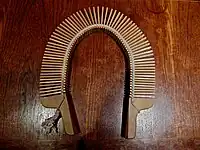
A binzasara

Binzasara (編木 or 板ざさら) is a traditional Japanese percussion instrument used in folk songs, and rural dances. It was originally used as a cleaning tool. The instrument is made up of several wooden plates strung together with a cotton cord, with handles at both ends. Typically, a binzasara will have 108 wooden slats which is a significant number in Buddhism. The stack of wooden plates is played by making them move like a wave.[1]
References
- ↑ 東京藝術大学 , 026-binzasara, May, 2009.
External links
Wikimedia Commons has media related to Binzasara.
- All about Hand Percussion - Techniques, notation and applications (Google Books)
- "Binzasara: Music and Dance at Sensōji in Edo/Tōkyō"
This article is issued from Wikipedia. The text is licensed under Creative Commons - Attribution - Sharealike. Additional terms may apply for the media files.